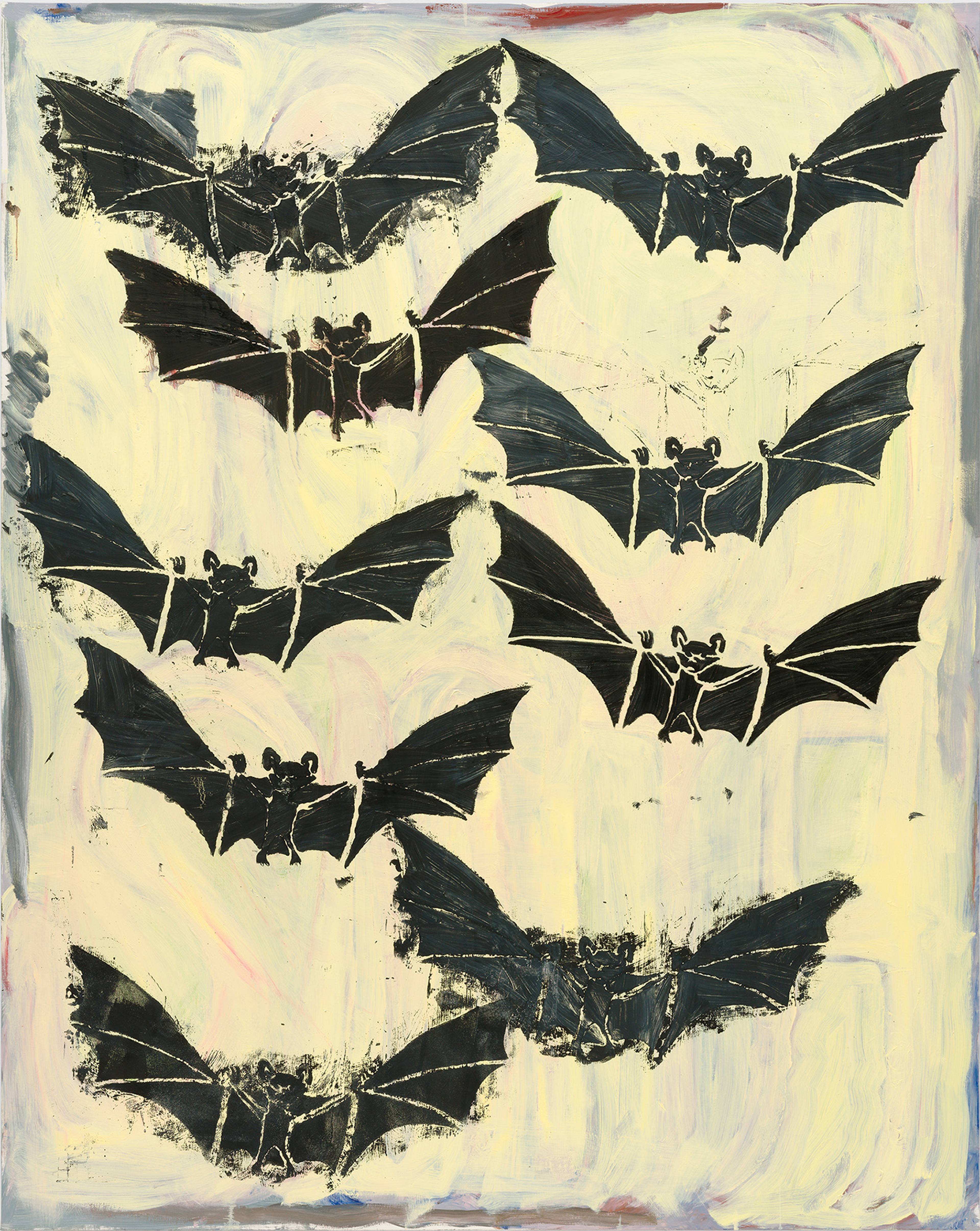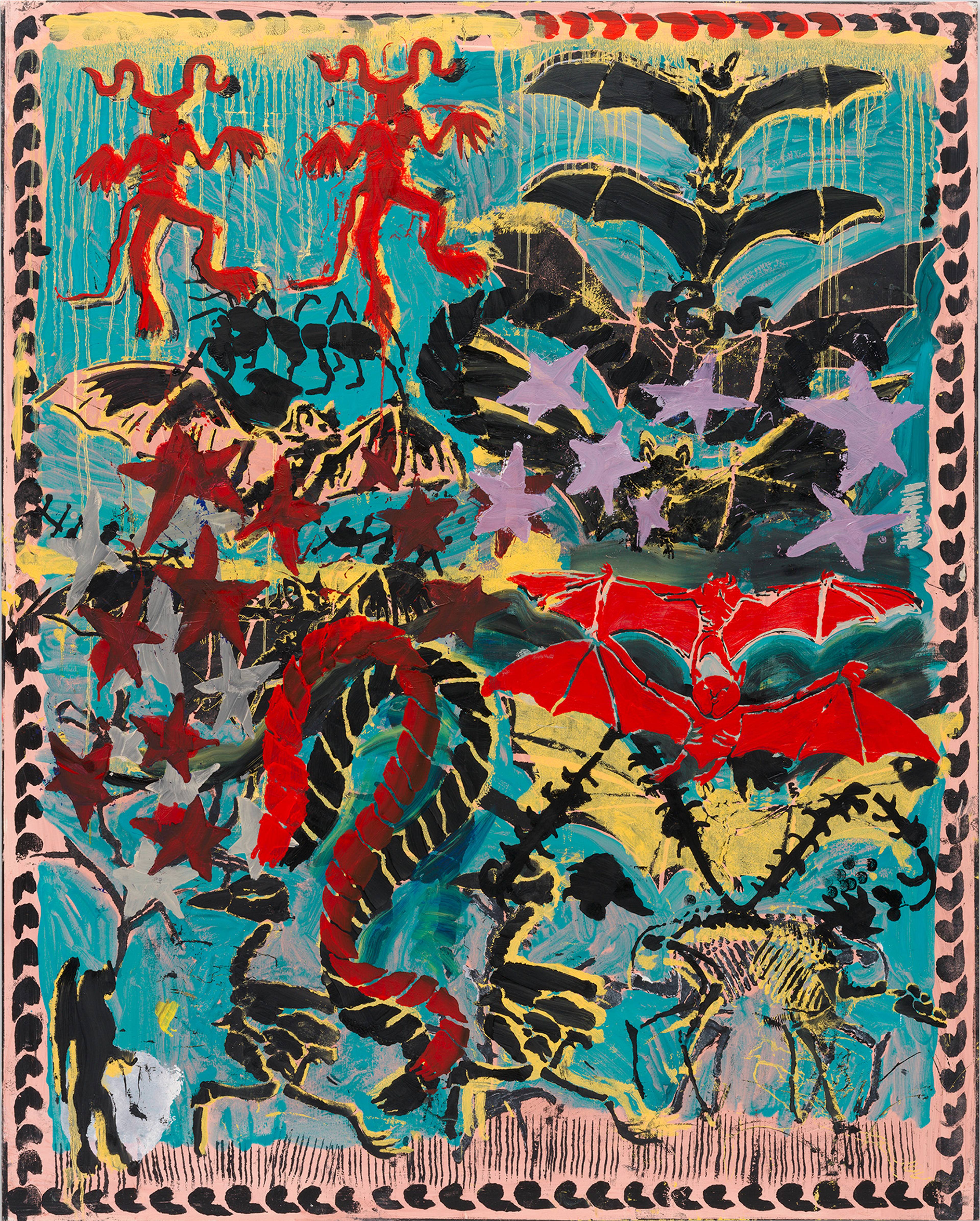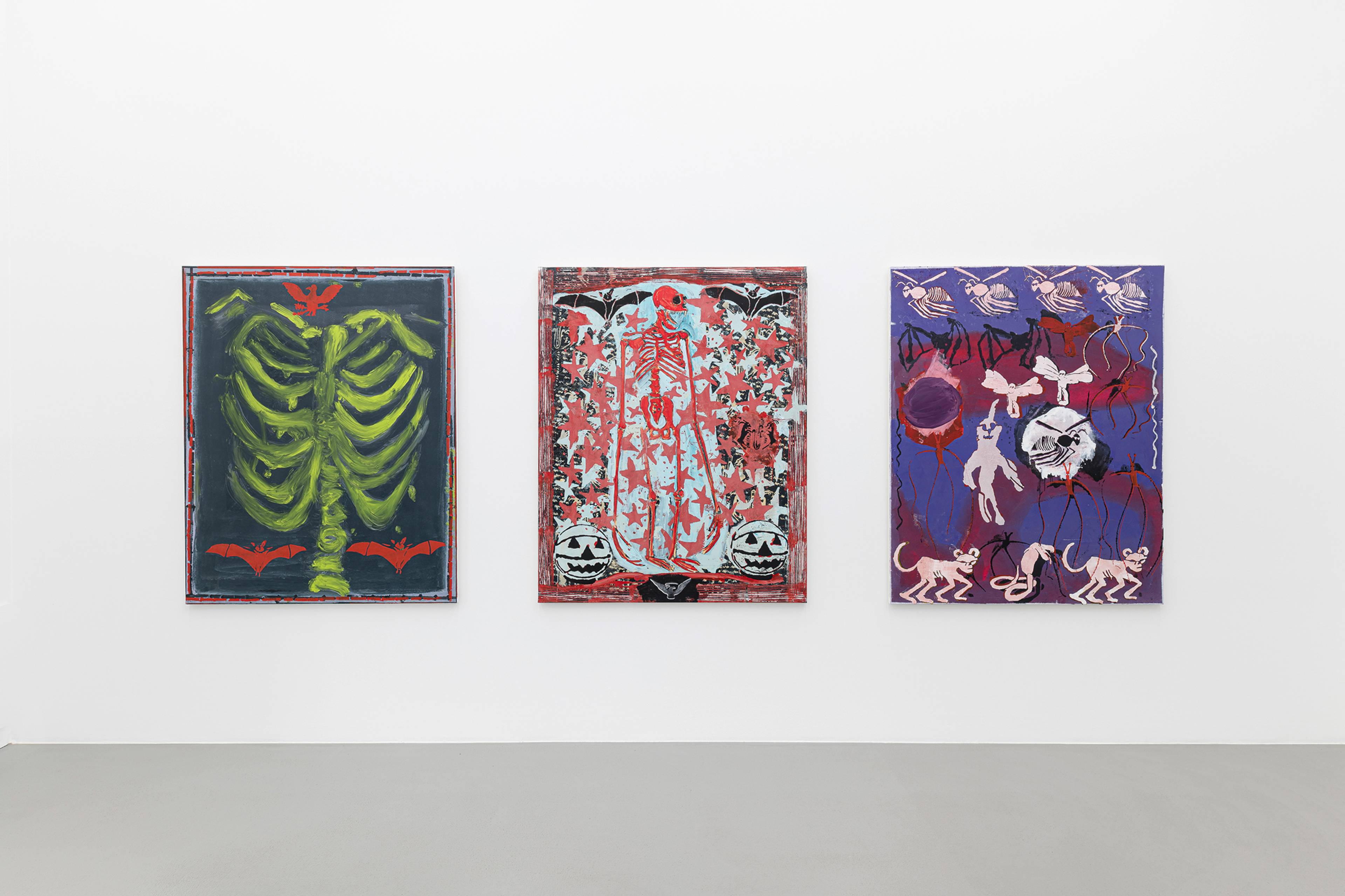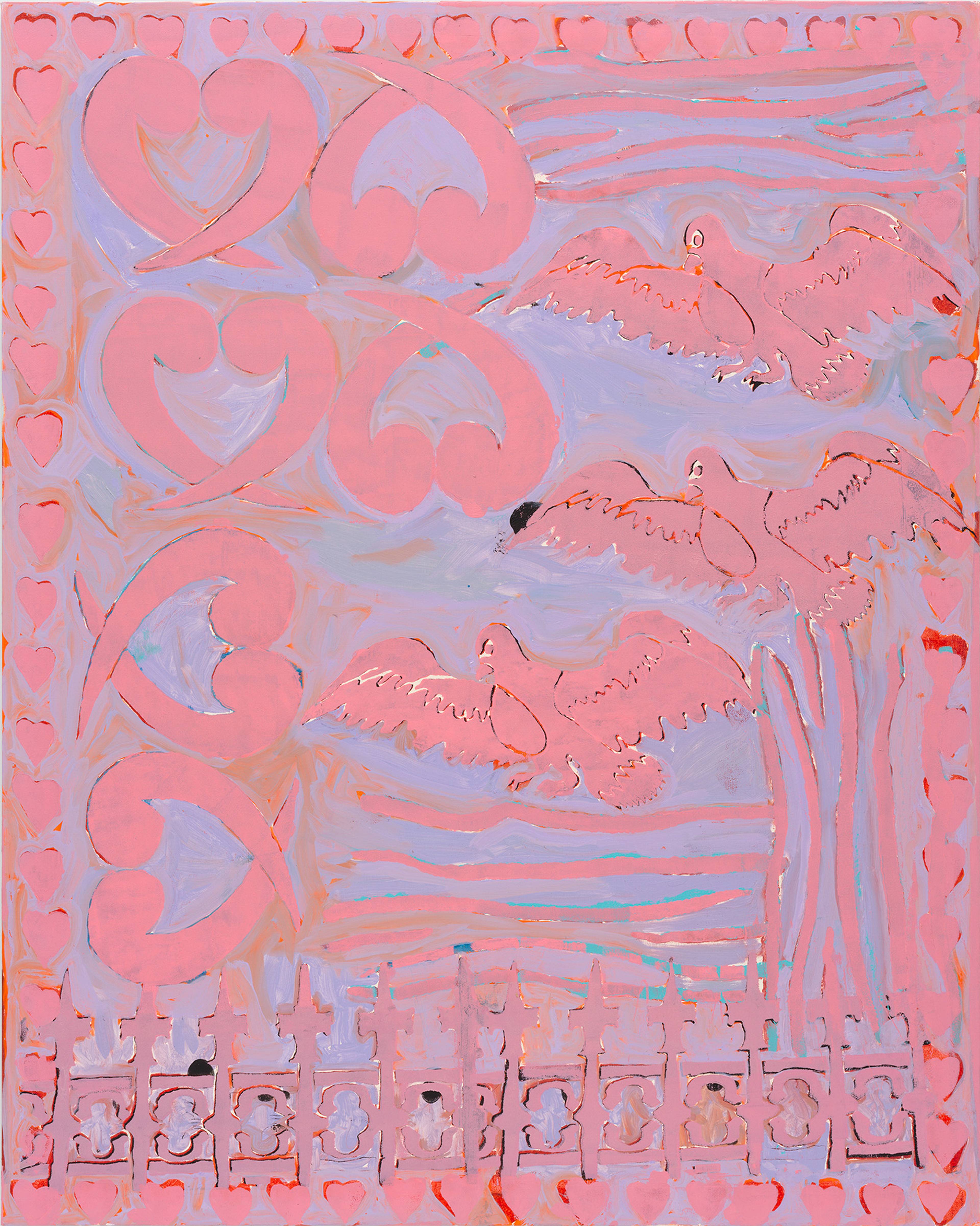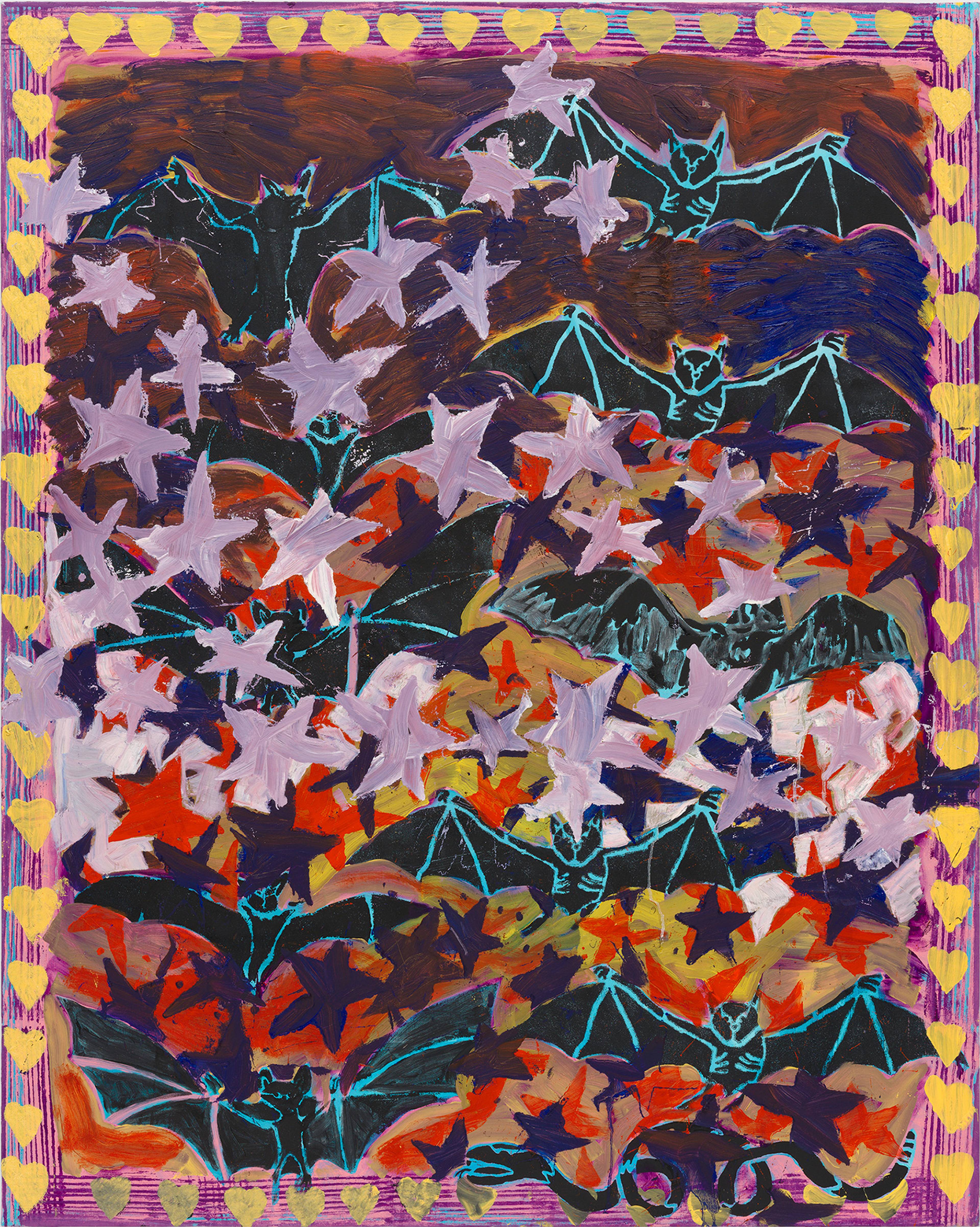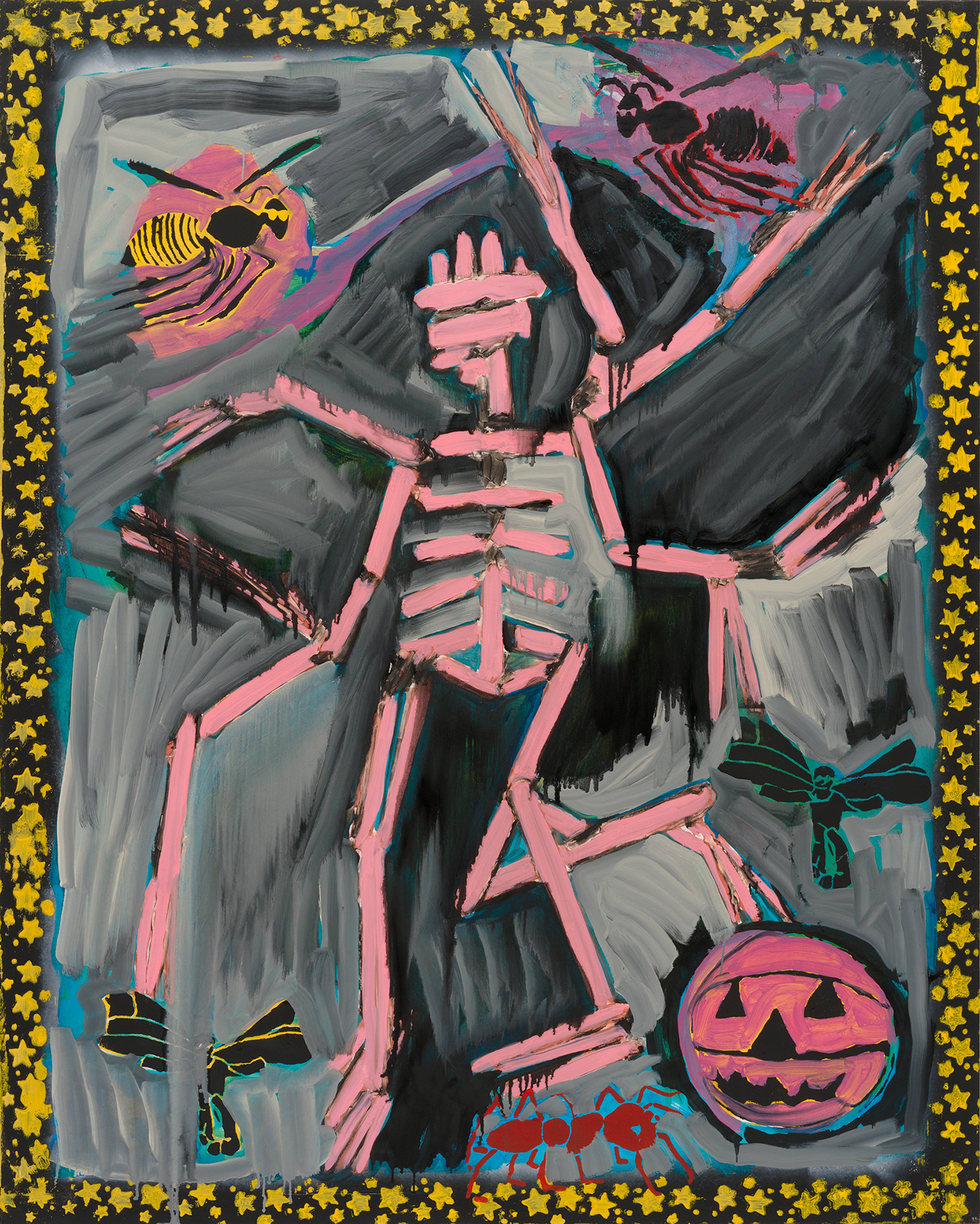Josh Smith (*1976) is a jack of all trades, mounting sculptures on necklaces, hosting a web series, and making ceramics, collages, and prints. His main occupation, though, has always been painting. Smith was propelled into public view two decades ago by an iconic series depicting his own name, in which he maps out the expressive possibilities of the individual gesture, as well as of repetition and variation. His output is extremely versatile, ranging from figurative paintings of clichéd or archetypal motifs – palm trees, fish, grim reapers, turtles, et al – to colorful, abstract compositions. In his sixth show with Galerie Presenhuber – and his first in the gallery’s space in Vienna – Smith shows a joyfully juvenile, yet bleak pictorial cosmos of stars and bats, bug-like creatures and snakes, skeletons and ghosts.
Ramona Heinlein: Josh, this show consists of sixteen paintings, and the use of stencils dominates throughout. Why is this technique interesting for you?
Josh Smith: I’m a gestural painter, and I wanted to take that away somewhat. I also limited my palette, so they’re not so crazy-colorful. I wanted there to be more restraint. I also didn’t want to tell a story, but to let them be abstract, using the stenciled images as mark-making.
RH: Having the flat background and the imprints on top is very ornamental. Why did you decide to let go of the expressiveness?
JS: I have been sharing my work for twenty years now, and I just wanted to change. For example, for Hope is a Thing with Wings (2024), I painted over one of my old name paintings; that is, I destroyed another painting to make a sharp turn. Also, my confidence changes: Sometimes, I feel really confident, but for these, I just didn’t feel like being Mr. Brush Guy. In fact, I used a roller for a lot of the backgrounds, and I tried to keep my fingers out of it as much as possible. Usually, I want to change things in the show, but I didn’t feel like that this time. I think that the stencils finalize something, they become a given. Like a readymade.
Josh Smith, Hope is a Thing with Wings, 2024, oil on linen, 152.5 x 122 cm
Josh Smith, Amalgamation, 2024, oil on linen, 152.5 x 122 cm
RH: Is this your first time working with stencils?
JS: No, I’ve done that before. I cut out all these bat stencils for a big, eight- or nine-meter painting of the grim reaper I did on the wall of the new Supreme store in Shanghai, for example, and I used them on these paintings here. It’s something I’ve been wanting to try out more, because the stencils don’t convey the emotion of regular painting.
RH: Paintings like Amalgamation (2024) are really energetic and wild, though. Did you do sketches for these?
JS: The painting usually comes together in the working. I don’t have an idea or a plan beforehand; I just make it. And, yes, I do sketches, but this is just not so easy to sketch. It’s more like a puzzle: You have the pieces and you have to build it, and I don’t know what I’m looking for until I see it. In Amalgamation, I wanted to make a mess, like a dirty painting that didn’t have the clarity of Hope is a Thing with Wings.
View of “Studio News,” Galerie Eva Presenhuber, Vienna, 2024
RH: There’s also a lot of chance in there, as with the drippings.
JS: Yes, and I could have worked on it forever. A big part of being an artist is just knowing when to leave it alone. I stop working when I feel like I am driving over the same tracks. It’s also okay to leave a painting unfinished, too. In my mind, the viewer can finish it. If you make a painting perfectly, it kind of excludes them.
RH: I think immediately about my youth when seeing the little hearts decorating Bright Blue Dawn (2024). It has something playful, but also affectionate to it. Could you tell me more about these frames or this edging you are making? That’s what you do at the end?
JS: Or at the beginning. I like them – they help to hold the painting together. And, yes, this is like a valentine. I love the heart shape. It’s like a poem.
You can think of the paintings like people: Some of them are injured; none of them are perfect.
RH: You mostly work in series, with a lot of repetition and variation, which has something obsessive to it. Is it a way for you to work through a certain emotion or thought? Painting to “figure” something out?
JS: Usually, with my paintings, I try to make a problem, and the attempt to solve it becomes the art. It’s not important whether I solve it or not. It’s the process that makes the painting, the different ways of projecting what my brain is going through. So, I’m not just executing something, but am gathering knowledge with my paintings.
RH: What does failure mean to you?
JS: Well, what’s the difference between failure and success? It’s a debatable thing. You can think of the paintings like people: Some of them are injured; none of them are perfect. I guess I learned stuff like that from Warhol.
Josh Smith, Bright Blue Dawn, 2024, oil on linen, 152.5 x 122 cm
RH: Yes, they are not precise or neat. You can see stains and spots.
JS: And the mistakes! I could have used silkscreen, too, but I didn’t want them to be as good as silkscreen. The painterliness comes from the poor quality of the stencils. The precision of a silkscreen is something I need to try another time.
RH: It is interesting that, in a way, they are so transparent. The viewer sees how they are done, right?
JS: Something that I always try to do with my art is to not hide how the works were made. They even feel like you could have made them. It’s about displaying the simplicity of what art can be.
RH: This show is very joyful and playful, but also a bit gloomy.
JS: Yes, it works. It’s got a lot of American in it, but it’s got some Austrian, as well – it’s a good collaboration between the two. They feel regal, and also clumsily American. We had a lot of stenciling in the US in former times. We couldn’t get wallpaper because wallpaper came from England. And I’m interested in that, like 17th-to-19th-century American architecture and decoration. I’ve done a lot of research on that.
View of “Studio News,” Galerie Eva Presenhuber, Vienna, 2024
RH: Your new show is called “Studio News,” like a series on your social media where you give little updates on your work, talk about shows or movies you’ve seen recently, etc. Where did your newfound joy in using Instagram and YouTube come from?
JS: I do a lot of shows and interesting things, and I never have a chance to share them. So, two years ago, I just started an Instagram account, and it’s been really fun. I know that a lot of people are tired of it, but I’m not. It’s a silly product, but it’s also very useful, even if it is kind of outdated – I like that, too. I also enjoy the performative aspect of it. I think of it like an artwork. And the grid is great, it reminds me of what I’ve done.
RH: So, it’s also a way of looking at your own work.
JS: Yeah, and I make fun of myself, even humiliate myself. I try to show my real personality, as opposed to an Instagram personality. A lot of artists don’t share their personality, which I find a bit cloistered. Whereas I’ve been cloistered for so long and don’t want that anymore. That being said, I could stop Instagram tomorrow.
Josh Smith, Behind the Clouds the Starlight Lurks, 2024, oil on linen, 152.5 x 122 cm
Josh Smith, Dancing in the Dark, 2024, oil on linen, 152.5 x 122 cm
RH: I remember one post where you said that this show might be the best ever. Did that work out?
JS: That’s just me being optimistic. It’s not the best ever, but it is interesting. If I ever get to do a survey show, I’m hoping that the variety will be useful. I think that people change and that art sort of changes, too, and if you look back at artists from the past, the good ones, in my opinion, all changed. They didn’t do the same thing all their life. That’s conservative, and I’d rather fail. Even if my art career ended, I would keep being an artist, find some other creative thing. I am a person who has always made stuff, whether it’s furniture, art, or writing. I like being industrious.
RH: What do you wish from the spectators?
JS: You should just look and take something away from it; or, you don’t like it. But I don’t want it to be ambiguous.
RH: Indifference is the worst.
JS: Yes, or just banal. Like, a lot of art shows you see, you just walk in and walk out. I want people to either hate it or love it. I don’t want to be in the middle.
___
“Studio News”
Galerie Eva Presenhuber, Vienna
24 May – 20 Jul 2024



